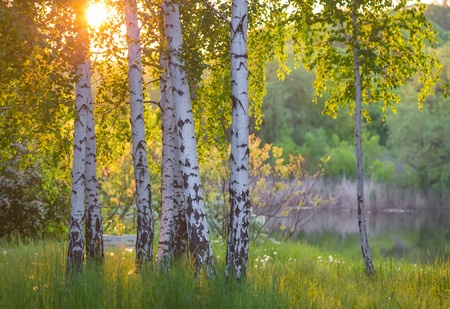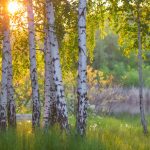
Birch (Betula alba L. family: Cupuliferae) is a member of about 40 known species throughout the Northern hemisphere in the Betulaceae family. This particular one is also known as Black, Cherry, Sweet or Spice Birch and in some places Mountain Mahogany and reaches nearly 50 ft. It has a particularly smooth trunk in early maturing trees but becomes striated with horizontal lines as it matures further. It is also a particularly attractive tree with a long history associated with mythical fairy tales and fold medicine.
Whilst it is a North American tree, the Russians and people in the Baltic States consider it with long held romanticism. It makes for an excellent Bania where the leaves are draped over extremely hot rocks and the vapours breathed in. It is meant to improve their physical stamina. To help with this treatment, a Birch Broom or Beresovy Venic is used to literally flay the body. A bath containing birch has been used traditionally to treat skin problems.
Look through the fossil records and you will find this ancient tree in Cretaceous rocks in all the major continents. It is now widely distributed throughout the United States, even as far south as the Everglades and the hotspots of Texas. It is however more associated with colder climates in Northern forests.
Medicinal Properties
The bark and the leaves have seen widespread use in North American tribal medicines. It has been applied as a wash or infused into alcohol. Its is most effective as an aromatic, a stimulant and as a diuretic.
Compounds
Contains betuloside (rhododendrin) which is a glycoside containing a natural phenol.
History Of Use
The Northern American tribes regularly collected the leaves as food but also to prepare a medicine. The bark syrup is regularly tapped for a beverage and preparation of a syrup which we have regularly promoted. Oil of Wintergreen is distilled from the inner bark and twigs and used to treat sun burn and other irritations of the skin – effective it is too !
The Indian tribes used the birch in all its forms to treat dysentery and diarrhoea especially (rather similar to Alum Root in this respect). Cholera and intestinal tract issues have also be treated but this is probably associated with purifying the blood, treating rheumatism, gout and bladder/kidney stones. Can it treat worms as well ? It’s never been firmly established in North American culture but there is some evidence for it has a helminth treatment.
Applications
Whilst birch water sap is a source of manganese, the leaves or bark are infused into boiling water for 15 minutes. Between 3 to 5 cupfuls should be drunk along with other herbal teas to help overcome the astringent flavour. The sap is attracting great interesting as a beverage in its own right.
Birch oil is a treatment for skin conditions including eczema and is gargled to sooth infections such as canker and mouth sores. Stronger extracts as far as we can tell were applied to treat sores, ulcers and boils. We’ve already mentioned treatment of aches such as rheumatism and swelling.
Birch charcoal is often eaten to treat wind ! Birch makes for an excellent slow burn and charcoaling was a common site of the woods following colonisation in the USA.


I like this picture of the birch trees. Brilliant picture.